INTRODUCTION
Typical waterborne acrylic paints and mediums dry relatively quickly due to the evaporation of water and some other volatile components. Traditional uncovered palette systems only work well with acrylics if you are working very quickly because of this fast dry time. Our very slow-drying OPEN Acrylics are an exception, but for the purpose of this article we are only addressing palette options for use with our regular drying acrylic products in studio environments, such as our Heavy Body Acrylics. OPEN Acrylics are generally the best solution for a plein-air palette solution.
The best solutions are quick use disposable palette surfaces, such as palette paper and various types of plastic surfaces, covered palettes or pre-mixed colors stored in plastic containers with lids. Avoid using any kind of porous material such as wood, paper or cardboard, as this will only speed up the drying due to absorption of water into these surfaces, and the acrylic will adhere permanently, making clean up impossible. Below we will go into more detail about these different options and provide some suggestions and ideas for managing theses different palette systems.
OPTIONS
Uncovered, Quick Use, Disposable Palette Surfaces: Palette paper, freezer paper, polyethylene plastic sheeting, or plastic containers can work as quick use mixing surfaces, using just enough paint for your immediate purposes at hand. Any wet paint that remains can be stored in properly labeled airtight containers or allowed to dry, then disposed of or be used as acrylic skins for collage.
To extend the working time on this and other types of palettes you can always blend in up to 15% Retarder into the paint, or you can mist or spray water or a blend of water and OPEN Thinner in a 3:1 ratio (3 parts water to 1 part OPEN Thinner). It is important to label this spray bottle as “GOLDEN OPEN Thinner with water” for safety and convenience. In testing, the OPEN Thinner and water mixture allowed for hours of working time on an open palette when sprayed every half hour. There are a variety of types of spray bottles and misters that can work, with some that provide a finer and more controlled mist.
Acrylic paints and mediums after full drying can be easily peeled off of most plastic or glass palettes and then used as collage elements:
Reusable Palettes without Covers: Glass, ceramic, enameled metal, or plastic palettes can be used. We do not recommend the use of Plexiglas or other types of acrylic sheeting, as acrylic paints and mediums can adhere permanently. Enameled butcher trays have raised sides to allow covering. All these surfaces can be used without lids for a short work time, but for any longer term use, some way of covering the palette would be necessary. Again, misting every 30 minutes or so with a water / OPEN Thinner mixture can be helpful in keeping the paints workable on the palette for hours.
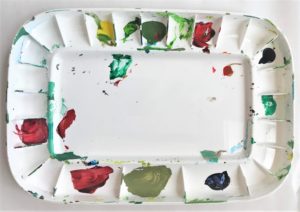
Palettes with Covers:
There are many options for covered palettes, both “home made” and within the art materials marketplace. Airtight containers such as Tupperware® can work well. Generally speaking, any shallow plastic (not acrylic), ceramic or enameled container could work. The simplest solution is a tray with walls or a lip that allows for covering with plastic wrap. While low and shallow profiles with less headroom will help keep the paint wet longer, deeper containers can hold smaller individual containers. You could also place a glass or plastic palette inside a low walled plastic container with a lid. This allows you to take the palette out and clean it so you don’t have to clean out the whole container. A few pieces of strong tape adhered to the underside of the palette can be used to pull the palette up and out of the container when necessary for cleaning.
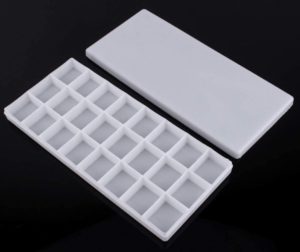
Wet Palettes
Included in this category are the “Wet Palette” systems. These are low profile, flat covered plastic containers that use a thin moistened sponge with a piece of semi-absorbent paper material on top. This system can work well, but you must watch for mold growth and clean the palette on a regular basis. Refer to the manufacturer’s instructions for ways to reduce microbial growth, which often includes using small amounts of household ammonia. We have found that when misted with water or a mixture of water and OPEN Thinner on a regular basis, plastic palettes with covers can work very well without any sponge inside, as long as you keep the container closed as much as possible. The less “head room” in closed palettes like this will keep the paints wetter for a longer period.
Pre-Mixed Colors Stored in Plastic Containers with Lids:
This method expands on the traditional idea of a palette. The solution here is to pre-mix a large array of colors and store them in separate containers. These plastic containers with lids can be stored on permanent shelves in the studio, or on movable carts, or both. They should all be clearly and accurately labelled with the contents for safety purposes. For ease of selection and use, a swatch of the mixture can be put on the lid so you can easily see the dry color, along with its surface sheen and level of opacity or translucency. This can be helpful, due to the wet to dry color shift with acrylics.
These mixtures can be a lot more than just color mixes too; they can be special mixtures of paint and any medium, gel or paste that you like, in any ratio you like, that suits the way you work. You could have a whole series of very translucent glazes, for instance, or tints, or very matte or glossy or highly textural mixtures. The list is endless and this method can save time and effort in the studio trying to match colors or surfaces while working.
This method can streamline your work flow in the studio as your colors and color and medium mixtures will be readily available and can include many more choices and options than you could mix up on a single small surface. Reusing empty paint or medium jars can save on plastics. Empty paint tubes and jars can be purchased at art stores. For any paints, mediums or mixtures stored in containers, it is very important to clearly label the containers with all the ingredients used for future reference and for product identification in case of accidental ingestion by pets or children.
Airtight lids, keeping the lids on when not in use, and storing the containers in a cool place out of sunlight are necessary to keep the paint mixtures from drying out. If using water in such mixtures, make sure to use distilled water in order to avoid or reduce microbial growth and adding a few drops of clear household ammonia to these mixtures can also help in this regard. Mixtures with no water added will not typically have these issues.
CONCLUSION
Choose a method that fits best with the way you work. These options can be used alone or in combination. Drying time will be highly variable due to the weather and climate where you live or the indoor environment. Air conditioning can create a much drier situation that can speed up drying. In lieu of living in or near a rain forest, using a humidifier in your studio can be very helpful in slowing the drying time. The overarching thought here is to create a system that takes into account and works within the natural parameters of waterborne acrylics, so your studio experience allows you to work as freely as possible.
OPEN Thinner: http://www.goldenpaints.com/technicalinfo_openthin
Retarder: https://www.goldenpaints.com/products/medium-gels-pastes/additives
About Scott Bennett
View all posts by Scott Bennett -->Subscribe
Subscribe to the newsletter today!
No related Post

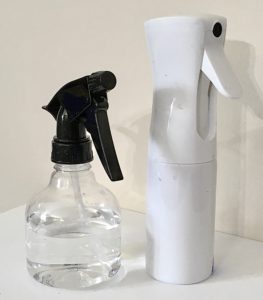
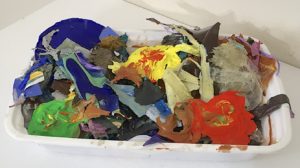
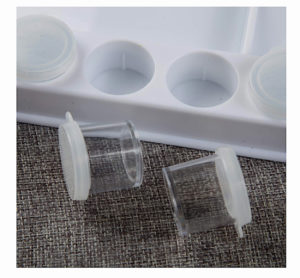

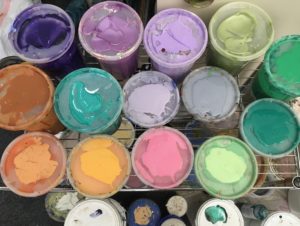
great article Scott (as always) cheers !!
Thanks Errol!!
I am just reading your article on types of pallettes. I use acrylics and casein in my art. To prevent mold, I place a copper penny(s) beneath the damp sponge in my Sea-Wet palette. I use two pennies in my 12×16 palette.I do not add ammonia or anything else. So far, no mold has occurred and I leave it out all the time. I live in southern Oregon and we experience very hot and dry weather.
I ran across this online. You might want to test this at some point.
J R
Hi Judie,
We have read that adding copper metal in some form to these kind of palettes can assist with mold reduction, so if it works, then that sounds like a good solution! Thank you for the confirmation with this method!!
Thanks for your 2 cents!
This was very helpful, I have been mixing my colors and storing in small containers but had no idea about the mold, I’ve been using filtered water, but I can get distilled. Thank you, Stacey Miller
Hi Stacey,
The mold issue was addressed in relation to the “wet palette” type of closed palette system that uses a moist flat sponge, but we would not expect mold in a closed plastic container. However, there can be some microbial growth ( bacteria ) that like to grow in acrylic and can make the acrylic mixture smell pretty bad. This only happens when the acrylic mixtures are thinned with a lot of water, as this dilutes the anti-microbial additives we use.
Thanks for the tip, Scott. I have had that very issue- smelly mold in sealed containers. Never realized that using tap water could be the culprit. I’ll use distilled water from now on. I appreciate your expertise and sharing it with us. Thanks! ~Tim Chambers
Thanks so much for these articles — very helpful! BTW, Talenti Gelato is sold in plastic pint containers with screw-on lids that are perfect for storing acrylic pre-mixes. Of course, you have to eat the Gelato first, but (sigh), art demands sacrifices, yes?
Hi Deborah,
You are most welcome! And yes, there are lots of possibilities for re-using plastic containers and I have personally also used the ones you mention. I tend to prefer snap off lids which are easier I think in terms of not having threaded surfaces. The really important thing here is to always create a clear label for these mixtures and place on the container for safety and convenience.
I’m using small water bottles for temporary diluted acrylic ink and acrylic watercolors. Most of the diluted solutions don’t last more than a week. Pigmnt separate. How fast can / will/ might microbes form? Thanks.
Hi Alice,
We cannot effectively comment on general categories of art materials such as “acrylic ink” or watercolor in general, regarding microbial growth, as this could easily vary depending on the formulas of the products which are generally proprietary to the manufacturers. However, you can generally assume that wet mixtures like this could easily provide a medium and environment for microbial growth, especially without any anti-microbial compounds added. A few drops of ammonia can sometimes be helpful to reduce this growth. Pigments will definitely settle with any very liquid mixture, and so mixing before using is important.
I use a covered palette with 54 wells that has a lid. I place sponges into several empty wells around the palette and am able to keep my acrylic paints (Golden Brand, of course!) viable for months. I apply water to each well using a spray bottle before I close up my palette at night. My storage palette is: Spectrum Palette from CheapJoes.com. When a well is empty, I simply add more acrylic paint and keep painting. After about two years, some of the wells start to dry out and fill up. I then start with a new palette. It works really well and I teach my students to do the same.
Donna Beverly donnabeverly.com
Hi Donna,
Thank you so much for this suggestion. There are indeed, many possible palette options and this sounds like a good one!
Hello Yoojooken,
You are most welcome! And yes, you can mix any of our acrylic paints or mediums alone or together and store in separate plastic containers. Please make sure you label them well for safety and convenience.
A sta wet palette is a must for me, but I’m in a very dry environment.